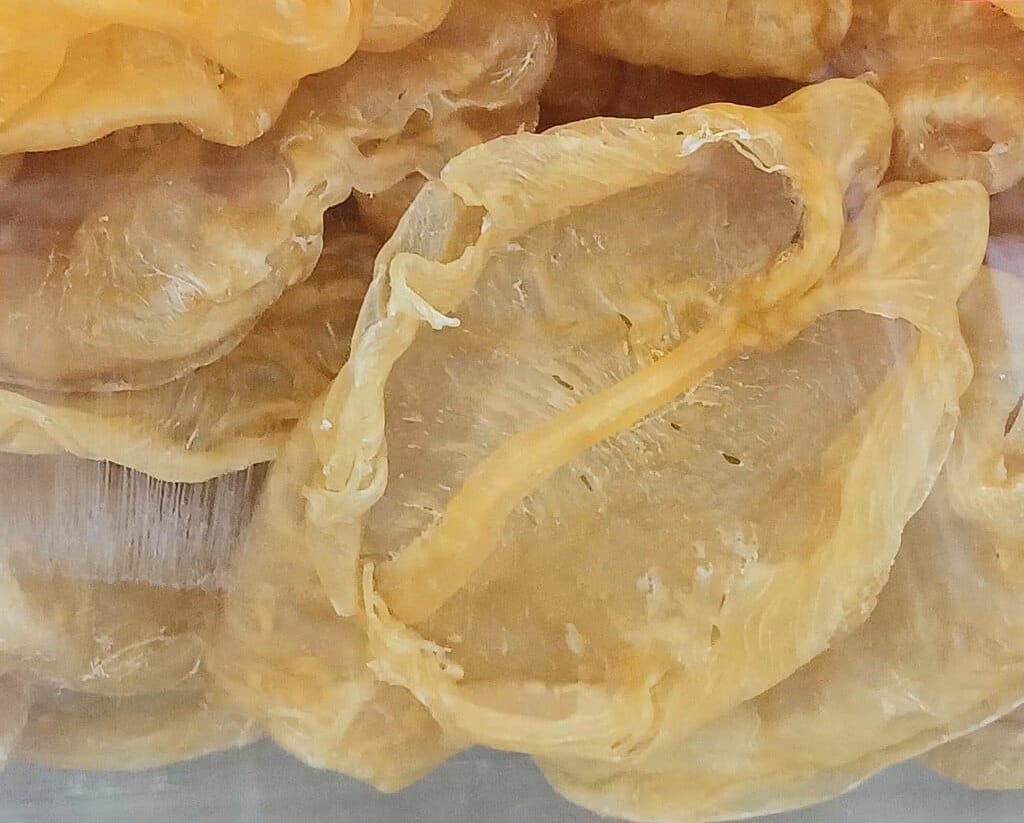The Science of Fish Maw: Collagen and Beyond
Fish maw, the dried swim bladder of large fish, contains concentrated type I collagen with unique properties. Its remarkable amino acid profile explains its potential benefits for skin elasticity, joint health, and metabolic function.

In luxury seafood markets across Asia, few items command the respect—and price tag—of fish maw.
This golden, spongy delicacy can fetch thousands of dollars per kilogram, placing it among the most expensive food ingredients in the world.
But what exactly is fish maw, and what scientific properties explain its coveted status?
Behind the cultural significance and culinary prestige lies fascinating biology and nutritional science that may justify the hype surrounding this unusual ingredient.
The Biological Origin: Not Just Any Fish Part
Fish maw is the dried swim bladder of large fish species.
The swim bladder serves as a hydrostatic organ—essentially an internal balloon that regulates buoyancy, allowing fish to maintain position in the water column without expending energy on swimming.
This specialized organ evolved as fish adapted to different oceanic depths, presenting a remarkable example of natural engineering.
The swim bladder works through a simple yet elegant mechanism: by adjusting the amount of gas (primarily oxygen) inside this internal chamber, fish can control their buoyancy.
When a fish needs to descend, it releases gas from the bladder through a specialized duct or absorbs it into the bloodstream. To ascend, it secretes gas back into the bladder. This biological adaptation essentially functions as a sophisticated ballast system.
Not all fish maws are created equal. The most prized specimens come from larger fish species with substantial swim bladders, particularly:
- Large croakers (Sciaenidae family)
- Bahaba (Bahaba taipingensis)
- Totoaba (Totoaba macdonaldi)
- Yellow croaker (Larimichthys polyactis)
- Sturgeon species
- Certain groupers
The size, thickness, and collagen density of the swim bladder correspond directly to its market value. The rarest specimens—like those from the critically endangered totoaba (Totoaba macdonaldi)—can command prices comparable to gold.
Chemical Composition: The Collagen Powerhouse
The extraordinary value of fish maw stems primarily from its unique chemical composition.
The swim bladder consists primarily of collagen proteins—approximately 76-80% of its dry weight. This makes it one of the most concentrated natural sources of collagen available.
The specific type of collagen in fish maw is predominantly Type I collagen, the most abundant form in vertebrate animals.
This particular type forms the structural foundation for skin, tendons, organs, and bones. What makes fish maw collagen especially interesting is its amino acid profile—rich in glycine, proline, and hydroxyproline, which form the characteristic triple-helix structure of collagen molecules.
Unlike mammalian sources of collagen, fish collagen has several distinct properties:
- Lower denaturation temperature: Fish collagen denatures (breaks down) at lower temperatures than mammalian collagen, making it more bioavailable when consumed.
- Higher absorption rate: Studies suggest that fish-derived collagen peptides may be absorbed up to 1.5 times more efficiently than bovine or porcine sources due to their lower molecular weight.
- Unique peptide sequences: Fish collagen contains specific peptide sequences that may offer distinct bioactive properties compared to other collagen sources.
Beyond collagen, fish maw contains small amounts of elastin, another structural protein, along with minerals including calcium, phosphorus, and trace elements that contribute to its nutritional profile.
Processing Science: From Swim Bladder to Delicacy
The transformation of a raw swim bladder into the golden, shelf-stable fish maw involves sophisticated processing techniques refined over centuries.
Modern understanding of food chemistry helps explain why these traditional methods work so effectively.
The processing typically involves:
- Extraction and cleaning: Once removed from the fish, the swim bladder undergoes meticulous cleaning to remove blood vessels, membranes, and fat deposits. This requires precision to preserve the integrity of the collagen structure.
- Drying: The cleaned bladders undergo controlled dehydration—traditionally in the sun, but increasingly in temperature-controlled environments. This critical step removes moisture without denaturing the collagen. The drying process typically reduces the water content from approximately 70% to below 15%.
- Bleaching and processing: Some varieties undergo mild bleaching to achieve the desired golden color and appearance. This step requires careful control of oxidation reactions to avoid damaging the collagen structure.
- Quality assessment: Modern processors use instrumental methods to analyze collagen integrity, including Fourier-transform infrared spectroscopy (FTIR) and high-performance liquid chromatography (HPLC) to evaluate protein content and quality.
The resulting product can be stored for extended periods without refrigeration, thanks to its low water activity level that inhibits microbial growth.
This shelf stability contributed to its historical significance in Asian cuisine during periods when refrigeration was unavailable.
The Health Science: Separating Fact from Fiction
The health benefits attributed to fish maw have roots in Traditional Chinese Medicine, where it has been prescribed for thousands of years.
Modern scientific research has begun to validate some of these traditional claims while providing mechanistic explanations.
Collagen and Skin Health
Perhaps the most substantiated benefit relates to skin health. As we age, endogenous collagen production declines approximately 1-1.5% annually after age 25, leading to the characteristic signs of aging.
Research in the Journal of Medical Nutrition and Nutraceuticals has shown that collagen supplementation can increase skin elasticity and hydration.
Fish collagen peptides, due to their lower molecular weight and higher bioavailability, may offer superior benefits compared to other sources.
Studies have demonstrated that hydrolyzed fish collagen can stimulate fibroblast proliferation, promoting the synthesis of new collagen fibers in the dermis.
Joint Health and Inflammation
Collagen is fundamental to joint structure, forming the scaffolding of cartilage.
Several clinical trials have shown that collagen supplementation may help reduce joint pain and improve mobility in individuals with osteoarthritis.
The specific amino acid profile in fish maw—particularly the glycine and proline content—appears to support cartilage regeneration and reduce inflammatory markers.
Several systematic reviews and clinical studies have examined marine collagen's effects on joint health.
For example, a 2019 review published in the Journal of Medicinal Food found that collagen supplementation improved joint pain and function in patients with osteoarthritis.
Additionally, a 2018 study in the International Journal of Medical Sciences demonstrated that marine collagen peptides specifically helped reduce activity-related joint pain in athletes.
Nutritional Profile and Metabolic Effects
Beyond collagen, fish maw contains a range of bioactive compounds that may offer metabolic benefits.
Its protein structure provides all essential amino acids in bioavailable form. Additionally, emerging research suggests that specific peptides derived from fish collagen may exhibit:
- Antioxidant activity
- Blood pressure regulation effects
- Improved glucose metabolism
However, it's important to note that many health claims surrounding fish maw lack robust clinical evidence. While the theoretical mechanisms make biochemical sense, more research is needed to establish definitive therapeutic applications.
Sustainability Concerns: The Scientific Challenge
The growing demand for fish maw presents significant challenges from a marine conservation perspective. Several species harvested for their swim bladders face population decline, with the Chinese bahaba now critically endangered largely due to demand for its valuable maw.
Researchers are exploring sustainable alternatives, including:
- Aquaculture optimization: Developing farming methods for species with valuable swim bladders
- Collagen extraction techniques: Creating methods to utilize swim bladders from more abundant species
- Plant-based and lab-grown alternatives: Engineering sustainable collagen sources with similar properties
These scientific approaches represent important directions for ensuring that the benefits of fish maw can be realized without devastating marine ecosystems.
Conclusion
Fish maw represents a fascinating intersection of evolutionary biology, protein chemistry, traditional medicine, and modern nutritional science.
Its unique collagen structure—evolved to serve the buoyancy needs of fish—happens to align remarkably well with human nutritional requirements.
While some health claims remain to be fully substantiated through rigorous clinical trials, the underlying biochemical properties of fish maw offer a compelling scientific explanation for its enduring reputation.
Whether consumed for its cultural significance, culinary properties, or potential health benefits, fish maw provides a window into the elegant complexity of marine biology and the remarkable ways in which natural adaptations can translate into valuable human resources.
As scientific understanding deepens, we may discover even more about this golden treasure from the depths.


